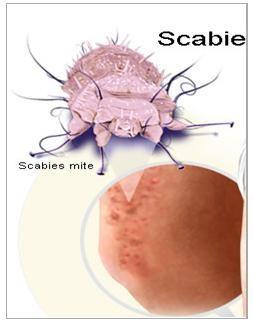Scabies
What is scabies?

Scabies is a skin disease caused by a parasite named Sarcoptes scabie tiny insect about 0.3 mm long called a mite. The female parasite burrows under the skin and begins laying eggs within 2-3 hours of infection and generally lays 2-3 eggs daily. The eggs hatch and become adult mites (a term referring to this parasite) within 10 days. Scabies is a relatively contagious infection caused by a tiny mite (Sarcoptes scabie).
Transmission
Transmission is person to person more by close skin contact. Likely to occur when partners spend the night together. Possibly from sleeping in infested bedding, wearing infested clothing, even routine contact such as shaking or holding hands.
The female mite burrows under the skin and begins laying eggs within hours (2-3 eggs daily). The eggs hatch and become adult mites within 10 days. Symptoms, primarily itching, appear approximately 4 weeks from the time of contact as a result of sensitization to the presence of immature mites.
A person with scabies is considered to be infectious as long as they have not been treated. Infested pieces of clothing and bedding are considered infectious until treated. After treatment, a person may unknowingly re-infest themselves by coming into contact with the same person who had scabies to begin with or with someone else who has scabie.
Symptoms
Presence of the mite burrow(s), reddish brown nodules or lesions, and persistent itching. Itching is known to worsen at night. The intense itching almost always caused by scabies is due to a reaction within the skin. The first time someone is infected with scabies, he or she may not notice any itching for a number of weeks (four to six weeks). With subsequent infections, the itchiness will begin within hours of picking up the first mite. Although the mites can only live away from human skin for about three days, sharing clothing or bedclothes can pass scabies among family members or close contacts. In May 2002, the Centers for Disease Control (CDC) included scabies in its updated guidelines for the treatment of sexually transmitted diseases.
Common sites are: webs and sides of fingers and toes, pubic and groin area, armpits, bends of elbows and knees, wrists, navel, breasts, lower portion of buttocks, occasionally the penis and scrotum, waist and abdomen; they are rarely found on the palms of the hands and soles of the feet, and rarely from the neck upward. Close contacts. In May 2002, the Centers for Disease Control (CDC) included scabies in its updated guidelines for the treatment of sexually transmitted diseases. Scratching seems to serve some purpose in scabies, as the mites are apparently often inadvertently removed. Most infestations with scabies are caused by no more than 15 mite’s altogether.
Infestation with huge numbers of mites (on the order of thousands to millions) occurs when an individual does not scratch, or when an individual has a weakened immune system. These patients include those who live in institutions; are mentally retarded, or physically infirm ,other diseases like leukemia or diabetes; are taking medications which lowers their immune response ,cancer chemotherapy, drugs given after organ transplant or have other diseases which lower their immune response (such as acquired immunodeficiency syndrome or AIDS). This form of scabies, with its major infestation, is referred to as crusted scabies or Norwegian scabies. Infected patients have thickened, crusty areas all over their bodies, including over the scalp. Their skin is scaly. Their fingernails may be thickened and horny.
Diagnosis
Diagnosis can be made simply by observing the characteristic burrows of the mites causing scabies. A sterilized needle can be used to explore the pearly bump at the end of a burrow, remove its contents, and place it on a slide to be examined. The mite itself may then be identified under a microscope.
Occasionally, a type of mite carried on dogs (Sarcoptes scabie var. canis) may infect humans. These mites cannot survive for very long on humans, and so the infection is very light.
Treatment
Several types of lotions (usually containing 5% permethrin) can be applied to the body, and left on for 12-24 hours. One topical application is usually sufficient, although the scabicide may be reapplied after a week if mites remain. Itching can be lessened by the use of calamine lotion or antihistamine medications.
Prevention
Good hygiene is essential in the prevention of scabies. Like daily bath wearing washed clothes .not wearing another person’s used clothes. .treatment should be taken to all members at a time. When a member of a household is diagnosed with scabies, that entire person's recently-worn clothing and bedding should be washed in very hot water and dry in hot sun.
Source : Portal Content Team
Last Modified : 9/14/2023
Acne causes, symptoms and remedies are described h...
Basic information on Malaria including symptoms, c...
This topic covers information about Amoebic Liver ...
Reasons for discharge from ear, symptoms and preca...
